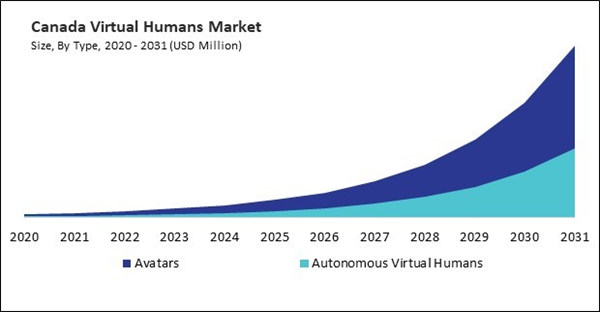The US market dominated the North America Virtual Humans Market by country in 2023, and is expected to continue to be a dominant market till 2031; thereby, achieving a market value of $199.78 billion by 2031. The Canada market is experiencing a CAGR of 45.4% during 2024-2031. Additionally, the Mexico market is expected to exhibit a CAGR of 44.4% during 2024-2031.
The market has emerged as a groundbreaking domain within the broader landscape of artificial intelligence (AI), augmented reality (AR), and immersive digital technologies. Virtual humans, synthetic humans, or digital avatars are AI-powered avatars designed to interact with real-world humans through conversational interfaces, sophisticated emotional responses, and natural language processing (NLP). This market is being shaped by technological advancements in AI, machine learning, natural language processing, and facial recognition, driving the creation of lifelike avatars that can simulate human behaviour, emotions, and speech patterns. As these avatars become more advanced, their applications span various sectors, including entertainment, customer service, healthcare, education, and retail.
The applications of virtual humans extend across multiple industries, capitalizing on the need for more efficient, scalable, and engaging interactions between humans and digital entities. Virtual humans are transforming customer service by acting as intelligent virtual assistants. These digital avatars can engage in complex conversations, providing instant customer support through text or voice. They can handle common queries, troubleshoot problems, process orders, and offer personalized product recommendations. In banking, telecommunications, and e-commerce industries, virtual humans are increasingly deployed to streamline customer interactions, improving response times and enhancing the overall customer experience.
Mexico’s telecommunications sector has consistently outpaced the overall economy’s growth, primarily driven by mobile telephones, broadband services, and broadcasting. In 2022, Mexico had over 130 million active wireless lines, with over 113 million having Internet access. This number is expected to exceed 138 million active wireless lines by the end of 2023.
The rapid expansion of the telecommunications sector in Mexico is a crucial catalyst for the market. With a growing number of active wireless lines and widespread internet access, the demand for AI-driven virtual assistants and digital avatars is rising. These virtual humans can provide customer support, enhance user engagement, and facilitate online services. In telecommunications, virtual assistants can manage customer inquiries, offer technical support, and personalize user experiences. The increasing internet penetration and mobile connectivity ensure more users can interact with virtual humans, thereby driving market growth in Mexico. In conclusion, the significant investments in Canada’s healthcare sector and the rapid growth of Mexico’s telecommunications sector are pivotal in driving the expansion of the market.
List of Key Companies Profiled
- Epic Games, Inc.
- Alibaba Cloud (Alibaba Group Holding Limited)
- Unity Software Inc.
- Meta Platforms, Inc.
- Google LLC (Alphabet Inc.)
- IBM Corporation
- Microsoft Corporation
- Amazon Web Services, Inc. (Amazon.com, Inc.)
- Apple Inc.
- NVIDIA Corporation
Market Report Segmentation
By Type
- Avatars
- Autonomous Virtual Humans
By Industry Vertical
- Gaming & Entertainment
- BFSI
- Education
- Retail
- Healthcare
- Automotive
- IT & Telecommunications
- Other Industry Vertical
By Country
- US
- Canada
- Mexico
- Rest of North America
Table of Contents
Companies Mentioned
- Epic Games, Inc.
- Alibaba Cloud (Alibaba Group Holding Limited)
- Unity Software Inc.
- Meta Platforms, Inc.
- Google LLC (Alphabet Inc.)
- IBM Corporation
- Microsoft Corporation
- Amazon Web Services, Inc. (Amazon.com, Inc.)
- Apple Inc.
- NVIDIA Corporation
Methodology

LOADING...








